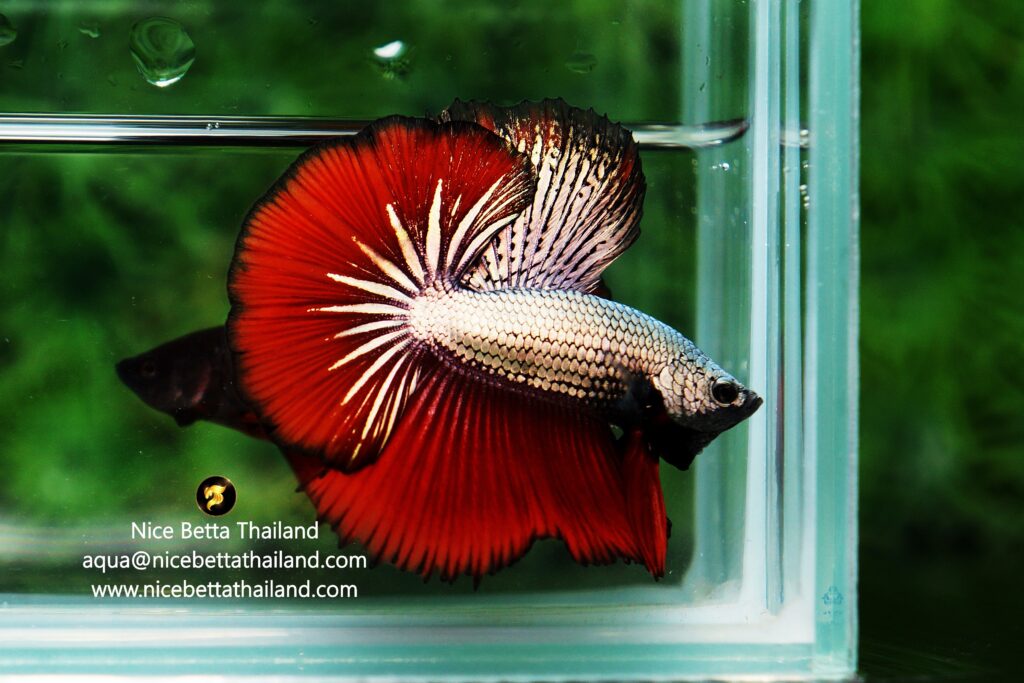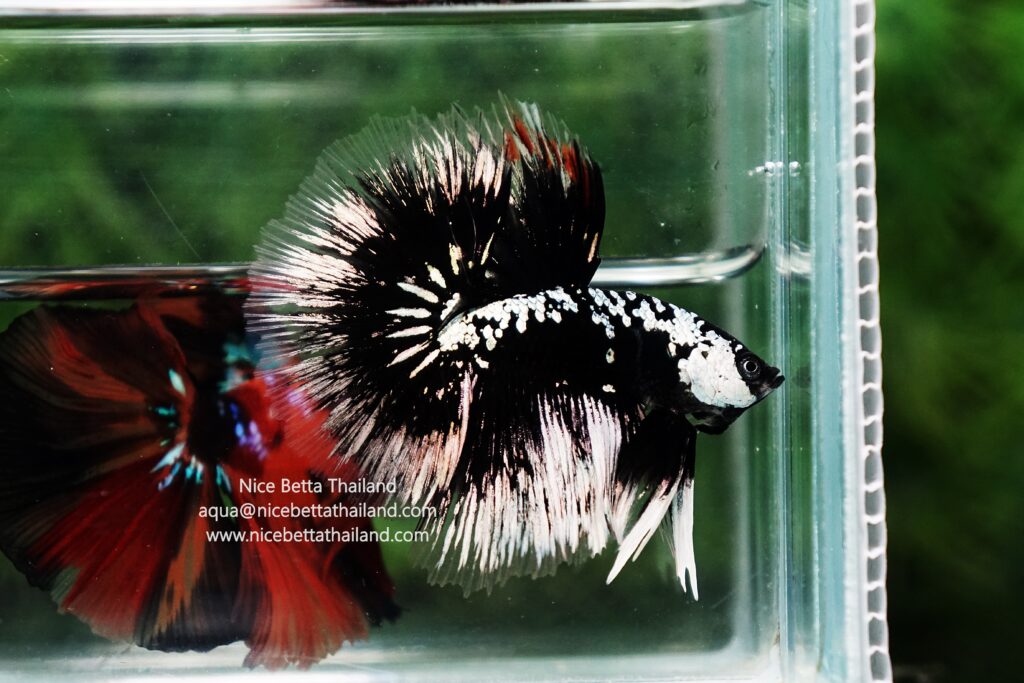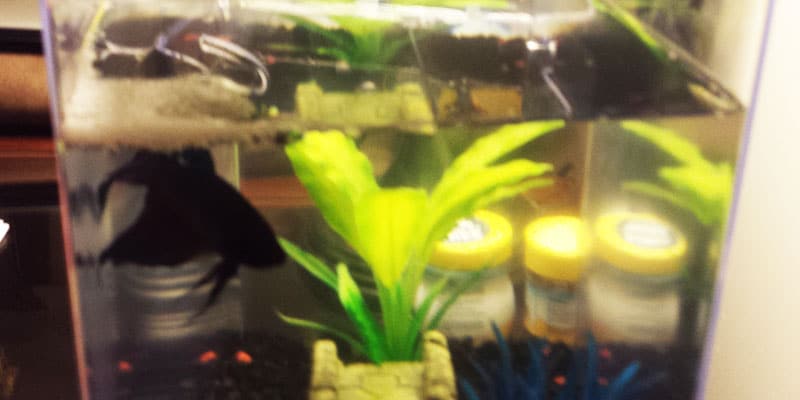Male betta splendens, like the betta fish make bubbles and build bubble clusters (nests) for reproduction. It’s the first step in the mating process with nest building starting as soon as they are old enough to reproduce.
The bubbles act as a safe haven for the eggs during incubation and for the fry until they are old enough to swim and get oxygen from the surface on their own. Bubble nests, which are also commonly referred to as foam nests, are created by gulping air and blowing oral secretion (saliva) bubbles, near the surface of the water.
In your tank, you can identify a bubble nest as the collection of bubbles on the surface of the water. The male will instinctively build a bubble nest with or without a female present. This is why you may find a bubble nest in your tank even if your betta has never seen or had contact with a female.

Bubble Nests and Mating In The Wild
In the wild, a male betta fish must fight for his territory against others. Once his territory is established, his nest is typically built under leaves or other types of debris. If a female is present for mating, and she deems the nest suitable, the male will coax her under the nest until she submits.
After the male’s embrace and the spawning have occurred, it’s the male’s job to collect the eggs with his mouth, and then place them in the bubble nest. There he guards the eggs, ensuring they do not fall out of the nest. He protects them from potential predators until they are old enough to survive on their own. Mating in captivity is, however, only recommended for experienced hobbyists.

Betta Bubble Nest Building Frequency
All betta fish are unique, and therefore the frequency of their nest building will also be unique. Some bettas may build one on a regular basis, while others might be more infrequent or not at all. Daily, weekly, or monthly are all common time-frames for male bettas to construct a nest.
Some nests are large, some are small, and their thickness can also vary. Regular bubble nest construction can be a sign that your betta fish is happy and healthy, and would be suitable for mating. It’s also an indication that your betta feels safe and has established his tank as his territory. Adequate plants and places to hide will help to create a less-stressful and safe environment.

What If A Male Betta Is Not Making A Bubble Nest?
If you have never seen your betta fish build a bubble nest, don’t panic! There is no real necessity for him to build a nest unless you plan on breeding. A lack of nest building behavior does not necessarily mean your siamese fighting fish or betta fish is unhappy or unhealthy.
Reasons Why A Betta May Not Make A Bubble Nest
- Current age and level of health
- Strong filtration units causing strong water current
- Poor water quality and cleanliness
- Water temperature is too cold (ideal is 78-82 degrees Fahrenheit)
- Lack of plants, decor, or surface debris
Properly caring for a betta fish does go a long way in providing the right environment and conditions for nest building.
Bubble Nest Motivation (how to encourage making one)
Different stimuli have been associated with nest building behavior. These may include changes in temperature, fluctuations in rainfall, barometric changes, tank materials, and the presence of females, or even other males.
Whether you’re interested in breeding your betta or just curious what a bubble nest looks like in person, there are ways to help encourage your betta to construct one.

DIY Floating Debris
While live plants found in their natural habitat, like the Indian Almond Leaf, are best, you can also use regularly found household items if you’re on a budget. Floating debris encourages a male betta to build his nest under it because of the protection it provides.
Take a styrofoam cup and cut it in half lengthwise. Then lay it on the surface of the water. Check back periodically for any signs of a nest being constructed beneath it.
Plastic lids from food containers also work well. The lid from a Pringles Chip can, for example, is a decent size and easy to add to the surface of the water. Make sure any item you introduce has been cleaned with hot water (no soap) first.
How To Clean Your Tank Without Ruining A Betta’s Nest
What if you find this wonderful work of art called a bubble nest and it’s time for a cleaning? First, you’re filled with excitement. Next comes anxiety about what to do with the nest and how to clean your tank without ruining the bubble nest your betta worked so hard to create.
It’s perfectly fine to destroy the nest for cleaning purposes as long as it doesn’t contain eggs. It’s more of a priority to have a clean tank than it is to salvage the nest. In fact, your betta will be less interested in making bubble nests again if the water is dirty. Worse yet, he could get sick.
If you’re feeling really guilty about keeping the nest intact, you can scoop up the nest with a plastic cup. Once you’re done cleaning the tank, gently place the nest back on the surface of the water.
If you have any further questions about why, how, when, or just want to share your own betta fish bubble nest stories, leave a comment below.
Also we have group talk about betta fish for sale and share any new tip take care information on Web3 socialFi group

Right now we have betta fish doctor help every bettas lover by top breeder in Thailand to cure or share more tip on Animalverse social
If your bettas fish sick or need tip to treat help Let’s join the group many top breeder will help to answers betta fish community
More tip :
How to breed betta fish for the desired color
All of Betta Fish A Guide on Patterns, Color in the world
What the difference between male and female betta fish
What are the bubbles top betta fish tank
The most expensive betta fish in the world.






